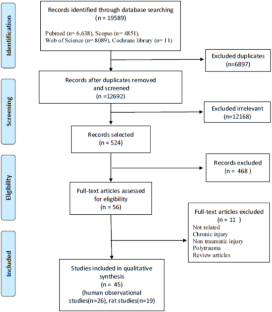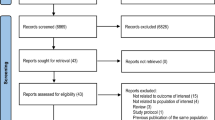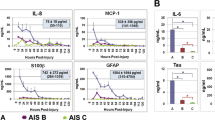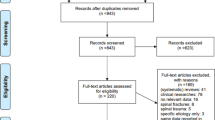Abstract
Study design
Scoping systematic review.
Objectives
To summarize the available experimental clinical and animal studies for the identification of all CSF and serum-derived biochemical markers in human and rat SCI models.
Setting
Tehran, Iran.
Methods
In this scoping article, we systematically reviewed the electronic databases of PubMed, Scopus, WOS, and CENTRAL to retrieve current literature assessing the levels of different biomarkers in human and rat SCI models.
Results
A total of 19,589 articles were retrieved and 6897 duplicated titles were removed. The remaining 12,692 studies were screened by their title/abstract and 12,636 were removed. The remaining 56 were considered for full-text assessment, and 11 papers did not meet the criteria, and finally, 45 studies were included. 26 studies were human observational studies comprising 1630 patients, and 19 articles studied SCI models in rats, including 832 rats. Upon reviewing the literature, we encountered a remarkable heterogeneity in terms of selected biomarkers, timing, and method of measurement, studied models, extent, and mechanism of injury as well as outcome assessment measures.
Conclusions
The specific expression and distribution patterns of biomarkers in relation to spinal cord injury (SCI) phases, and their varied concentrations over time, suggest that cerebrospinal fluid (CSF) and blood biomarkers are effective measures for assessing the severity of SCI.
This is a preview of subscription content, access via your institution
Access options
Subscribe to this journal
Receive 1 print issues and online access
We are sorry, but there is no personal subscription option available for your country.
Buy this article
- Purchase on Springer Link
- Instant access to full article PDF
Prices may be subject to local taxes which are calculated during checkout




Similar content being viewed by others
Data availability
All data generated or analyzed during this study are included in this published article and its supplementary files.
References
Tetreault LA, Karadimas S, Wilson JR, Arnold PM, Kurpad S, Dettori JR, et al. The Natural History of Degenerative Cervical Myelopathy and the Rate of Hospitalization Following Spinal Cord Injury: An Updated Systematic Review. Glob Spine J. 2017;7: 28S–34S.
Ahuja CS, Wilson JR, Nori S, Kotter MRN, Druschel C, Curt A, et al. Traumatic spinal cord injury. Nat Rev Dis Prim. 2017;3: 17018.
Kim YH, Ha KY, Kim SI. Spinal Cord Injury and Related Clinical Trials. Clin Orthopedic Surg. 2017;9: 1–9.
Stein DM, Sheth KN. Management of acute spinal cord injury. Continuum. 2015;21: 159–87.
Stahel PF, VanderHeiden T, Finn MA. Management strategies for acute spinal cord injury: current options and future perspectives. Curr Opin Crit Care. 2012;18: 651–60.
Ydens E, Palmers I, Hendrix S, Somers V. The Next Generation of Biomarker Research in Spinal Cord Injury. Mol Neurobiol. 2017;54: 1482–99.
Mattiassich G, Gollwitzer M, Gaderer F, Blocher M, Osti M, Lill M, et al. Functional Outcomes in Individuals Undergoing Very Early (<5 h) and Early (5-24 h) Surgical Decompression in Traumatic Cervical Spinal Cord Injury: Analysis of Neurological Improvement from the Austrian Spinal Cord Injury Study. J Neurotrauma. 2017;34: 3362–71.
Wutte C, Klein B, Becker J, Mach O, Panzer S, Strowitzki M, et al. Earlier Decompression (<8 h) Results in Better Neurological and Functional Outcome after Traumatic Thoracolumbar Spinal Cord Injury. J Neurotrauma. 2019;36: 2020–7.
White NH, Black NH. National Spinal Cord Injury Statistical Center, Spinal Cord Injury (SCI) 2016 Facts and Figures at a Glance. J Spinal Cord Med. 2016;39:493–4.
Kirshblum S, Waring W 3rd. Updates for the International Standards for Neurological Classification of Spinal Cord Injury. Phys Med Rehabilit Clin North Am. 2014;25: 505–17, vii.
Du W, Li H, Sun J, Xia Y, Zhu R, Zhang X, et al. The Prognostic Value of Serum Neuron Specific Enolase (NSE) and S100B Level in Patients of Acute Spinal Cord Injury. Med Sci Monit. 2018;24: 4510–5.
Roberts TT, Leonard GR, Cepela DJ. Classifications In Brief: American Spinal Injury Association (ASIA) Impairment Scale. Clin Orthop Relat Res. 2017;475: 1499–504.
Fawcett JW, Curt A, Steeves JD, Coleman WP, Tuszynski MH, Lammertse D, et al. Guidelines for the conduct of clinical trials for spinal cord injury as developed by the ICCP panel: spontaneous recovery after spinal cord injury and statistical power needed for therapeutic clinical trials. Spinal Cord. 2007;45: 190–205.
Rowland JW, Hawryluk GW, Kwon B, Fehlings MG. Current status of acute spinal cord injury pathophysiology and emerging therapies: promise on the horizon. Neurosurg Focus. 2008;25: E2.
Yousefifard M, Sarveazad A, Babahajian A, Baikpour M, Shokraneh F, Vaccaro AR, et al. Potential diagnostic and prognostic value of serum and cerebrospinal fluid biomarkers in traumatic spinal cord injury: A systematic review. J Neurochem. 2019;149: 317–30.
Strimbu K, Tavel JA. What are biomarkers? Curr Opin HIV AIDS. 2010;5: 463–6.
Badhiwala JH, Wilson JR, Kwon BK, Casha S, Fehlings MG. A Review of Clinical Trials in Spinal Cord Injury Including Biomarkers. J Neurotrauma. 2018;35: 1906–17.
Kwon BK, Casha S, Hurlbert RJ, Yong VW. Inflammatory and structural biomarkers in acute traumatic spinal cord injury. Clin Chem Lab Med. 2011;49: 425–33.
Hulme CH, Brown SJ, Fuller HR, Riddell J, Osman A, Chowdhury J, et al. The developing landscape of diagnostic and prognostic biomarkers for spinal cord injury in cerebrospinal fluid and blood. Spinal Cord. 2017;55: 114–25.
Wu Y, Streijger F, Wang Y, Lin G, Christie S, Mac-Thiong JM, et al. Parallel Metabolomic Profiling of Cerebrospinal Fluid and Serum for Identifying Biomarkers of Injury Severity after Acute Human Spinal Cord Injury. Sci Rep. 2016;6: 38718.
Moher D, Liberati A, Tetzlaff J, Altman DG. Preferred reporting items for systematic reviews and meta-analyses: the PRISMA statement. PLoS Med. 2009;6: e1000097.
Hassannejad Z, Sharif-Alhoseini M, Shakouri-Motlagh A, Vahedi F, Zadegan SA, Mokhatab M, et al. Potential variables affecting the quality of animal studies regarding pathophysiology of traumatic spinal cord injuries. Spinal Cord. 2016;54: 579–83.
Ga W. The Newcastle-Ottawa Scale (NOS) for assessing the quality of nonrandomised studies in meta-analyses. In 3rd Symposium on Systematic Reviews: Beyond the Basics. Oxford, UK; 2000.
Cao F, Yang XF, Liu WG, Hu WW, Li G, Zheng XJ, et al. Elevation of neuron-specific enolase and S-100beta protein level in experimental acute spinal cord injury. J Clin Neurosci. 2008;15: 541–4.
Ding SQ, Chen J, Wang SN, Duan FX, Chen YQ, Shi YJ, et al. Identification of serum exosomal microRNAs in acute spinal cord injured rats. Exp Biol Med. 2019;244: 1149–61.
Guo L, Hou J, Zhong J, Liu J, Sun T, Liu H. Association between injury severity and amyloid β protein levels in serum and cerebrospinal fluid in rats with traumatic spinal cord injury. Mol Med Rep. 2017;15: 2241–6.
Hasturk A, Atalay B, Calisaneller T, Ozdemir O, Oruckaptan H, Altinors N. Analysis of serum pro-inflammatory cytokine levels after rat spinal cord ischemia/reperfusion injury and correlation with tissue damage. Turkish Neurosurg. 2009;19: 353–9.
Li XH, Wu F, Zhao F, Huang SL. Fractional anisotropy is a marker in early-stage spinal cord injury. Brain Res. 2017;1672: 44–9.
Loy DN, Sroufe AE, Pelt JL, Burke DA, Cao QL, Talbott JF, et al. Serum biomarkers for experimental acute spinal cord injury: rapid elevation of neuron-specific enolase and S-100beta. Neurosurgery. 2005;56: 391–7.
Ma J, Novikov LN, Karlsson K, Kellerth JO, Wiberg M. Plexus avulsion and spinal cord injury increase the serum concentration of S-100 protein: an experimental study in rats. Scand J Plast Reconstruct Surg Hand Surg. 2001;35: 355–9.
Ma Z, Dong Q, Lyu B, Wang J, Quan Y, Gong S. The expression of bradykinin and its receptors in spinal cord ischemia-reperfusion injury rat model. Life Sci. 2019;218: 340–5.
Ur K, Demiroz S, Bengu AS, Ulucan A, Gergin OO, Kizmazoglu C, et al. Serum endocan level and the severity of spinal cord injury. Bratisl Lekarske listy. 2018;119: 298–301.
Wang CX, Olschowka JA, Wrathall JR. Increase of interleukin-1beta mRNA and protein in the spinal cord following experimental traumatic injury in the rat. Brain Res. 1997;759: 190–6.
Wu F, Ding XY, Li XH, Gong MJ, An JQ, Huang SL. Correlation between elevated inflammatory cytokines of spleen and spleen index in acute spinal cord injury. J Neuroimmunol. 2020;344: 577264.
Zong S, Zeng G, Fang Y, Peng J, Tao Y, Li K, et al. The role of IL-17 promotes spinal cord neuroinflammation via activation of the transcription factor STAT3 after spinal cord injury in the rat. Mediators Inflamm. 2014;2014: 786947.
Caprelli MT, Mothe AJ, Tator CH. Hyperphosphorylated Tau as a Novel Biomarker for Traumatic Axonal Injury in the Spinal Cord. J Neurotrauma. 2018;35: 1929–41.
Hong J, Chang A, Zavvarian MM, Wang J, Liu Y, Fehlings MG. Level-Specific Differences in Systemic Expression of Pro- and Anti-Inflammatory Cytokines and Chemokines after Spinal Cord Injury. Int J Mol Sci. 2018;19: 2167.
Mukhamedshina YO, Akhmetzyanova ER, Martynova EV, Khaiboullina SF, Galieva LR, Rizvanov AA. Systemic and Local Cytokine Profile following Spinal Cord Injury in Rats: A Multiplex Analysis. Front Neurol. 2017;8: 581.
Tanhoffer RA, Yamazaki RK, Nunes EA, Pchevozniki AI, Pchevozniki AM, Nogata C, et al. Glutamine concentration and immune response of spinal cord-injured rats. J Spinal Cord Med. 2007;30: 140–6.
Wang CX, Nuttin B, Heremans H, Dom R, Gybels J. Production of tumor necrosis factor in spinal cord following traumatic injury in rats. J Neuroimmunol. 1996;69: 151–6.
Yang Z, Bramlett HM, Moghieb A, Yu D, Wang P, Lin F, et al. Temporal Profile and Severity Correlation of a Panel of Rat Spinal Cord Injury Protein Biomarkers. Mol Neurobiol. 2018;55: 2174–84.
Shaw G, Yang C, Ellis R, Anderson K, Parker Mickle J, Scheff S, et al. Hyperphosphorylated neurofilament NF-H is a serum biomarker of axonal injury. Biochemical Biophysical Res Commun. 2005;336: 1268–77.
Ahadi R, Khodagholi F, Daneshi A, Vafaei A, Mafi AA, Jorjani M. Diagnostic Value of Serum Levels of GFAP, pNF-H, and NSE Compared With Clinical Findings in Severity Assessment of Human Traumatic Spinal Cord Injury. Spine. 2015;40: E823–30.
Bank M, Stein A, Sison C, Glazer A, Jassal N, McCarthy D, et al. Elevated circulating levels of the pro-inflammatory cytokine macrophage migration inhibitory factor in individuals with acute spinal cord injury. Arch Phys Med Rehabilit. 2015;96: 633–44.
Biglari B, Büchler A, Swing T, Biehl E, Roth HJ, Bruckner T, et al. Increase in soluble CD95L during subacute phases after human spinal cord injury: a potential therapeutic target. Spinal Cord. 2013;51: 183–7.
Biglari B, Büchler A, Swing T, Child C, Biehl E, Reitzel T, et al. Serum sCD95L concentration in patients with spinal cord injury. J Int Med Res. 2015;43: 250–6.
Biglari B, Swing T, Child C, Büchler A, Westhauser F, Bruckner T, et al. A pilot study on temporal changes in IL-1β and TNF-α serum levels after spinal cord injury: the serum level of TNF-α in acute SCI patients as a possible marker for neurological remission. Spinal Cord. 2015;53: 510–4.
Ferbert T, Child C, Graeser V, Swing T, Akbar M, Heller R, et al. Tracking Spinal Cord Injury: Differences in Cytokine Expression of IGF-1, TGF- B1, and sCD95l Can Be Measured in Blood Samples and Correspond to Neurological Remission in a 12-Week Follow-Up. J Neurotrauma. 2017;34: 607–14.
Hassanshahi G, Amin M, Shunmugavel A, Vazirinejad R, Vakilian A, Sanji M, et al. Temporal expression profile of CXC chemokines in serum of patients with spinal cord injury. Neurochemistry Int. 2013;63: 363–7.
Hayakawa K, Okazaki R, Ishii K, Ueno T, Izawa N, Tanaka Y, et al. Phosphorylated neurofilament subunit NF-H as a biomarker for evaluating the severity of spinal cord injury patients, a pilot study. Spinal Cord. 2012;50: 493–6.
Heller RA, Seelig J, Bock T, Haubruck P, Grützner PA, Schomburg L, et al. Relation of selenium status to neuro-regeneration after traumatic spinal cord injury. J Trace Elem Med Biol. 2019;51: 141–9.
Heller RA, Raven TF, Swing T, Kunzmann K, Daniel V, Haubruck P, et al. CCL-2 as a possible early marker for remission after traumatic spinal cord injury. Spinal Cord. 2017;55: 1002–9.
Jin GX, Li L, Cui SQ, Duan JZ, Wang H. Persistent hypoalbuminemia is a predictor of outcome in cervical spinal cord injury. Spine J. 2014;14: 1902–8.
Kuhle J, Gaiottino J, Leppert D, Petzold A, Bestwick JP, Malaspina A, et al. Serum neurofilament light chain is a biomarker of human spinal cord injury severity and outcome. J Neurol Neurosurg Psychiatry. 2015;86: 273–9.
Lee SJ, Kim CW, Lee KJ, Choe JW, Kim SE, Oh JH, et al. Elevated serum S100B levels in acute spinal fracture without head injury. Emerg Med J. 2010;27: 209–12.
Li H, Zhao D, Zhang M, editors. Temporal expression MicroRNA-21 in serum of patients with spinal cord injury. International conference on biomedical and biological engineering. Proceedings of the 2016 International Conference on Biomedical and Biological Engineering. Atlantis Press; 2016. pp. 116–22.
Moghaddam A, Child C, Bruckner T, Gerner HJ, Daniel V, Biglari B. Posttraumatic inflammation as a key to neuroregeneration after traumatic spinal cord injury. Int J Mol Sci. 2015;16: 7900–16.
Moghaddam A, Heller R, Daniel V, Swing T, Akbar M, Gerner HJ, et al. Exploratory study to suggest the possibility of MMP-8 and MMP-9 serum levels as early markers for remission after traumatic spinal cord injury. Spinal Cord. 2017;55: 8–15.
Moghaddam A, Sperl A, Heller R, Gerner HJ, Biglari B. sCD95L in serum after spinal cord injury. Spinal Cord. 2016;54: 957–60.
Paczkowska E, Rogińska D, Pius-Sadowska E, Jurewicz A, Piecyk K, Safranow K, et al. Evidence for proangiogenic cellular and humoral systemic response in patients with acute onset of spinal cord injury. J Spinal Cord Med. 2015;38: 729–44.
Papatheodorou A, Stein A, Bank M, Sison CP, Gibbs K, Davies P, et al. High-Mobility Group Box 1 (HMGB1) Is Elevated Systemically in Persons with Acute or Chronic Traumatic Spinal Cord Injury. J neurotrauma. 2017;34: 746–54.
Singh A, Kumar V, Ali S, Mahdi AA, Srivastava RN. Phosphorylated neurofilament heavy: A potential blood biomarker to evaluate the severity of acute spinal cord injuries in adults. Int J Crit Illn Inj Sci. 2017;7: 212–7.
Wang HC, Lin YT, Hsu SY, Tsai NW, Lai YR, Su BY, et al. Serial plasma DNA levels as predictors of outcome in patients with acute traumatic cervical spinal cord injury. J Transl Med. 2019;17: 329.
Wolf H, Krall C, Pajenda G, Leitgeb J, Bukaty AJ, Hajdu S, et al. Alterations of the biomarker S-100B and NSE in patients with acute vertebral spine fractures. Spine J. 2014;14: 2918–22.
Xu L, Zhang Y, Zhang R, Zhang H, Song P, Ma T, et al. Elevated plasma BDNF levels are correlated with NK cell activation in patients with traumatic spinal cord injury. Int Immunopharmacol. 2019;74: 105722.
Zhao P, Wang S, Zhou Y, Zheng H, Zhao G. MicroRNA-185 regulates spinal cord injuries induced by thoracolumbar spine compression fractures by targeting transforming growth factor-β1. Exp Therapeutic Med. 2017;13: 1127–32.
Bickenbach J, Shakespeare T, von Groote PM, World Health Organization, International Spinal Cord Society. International perspectives on spinal cord injury. World Health Organization; 2013. online source: https://www.who.int/publications/i/item/international-perspectives-on-spinal-cord-injury.
Grassner L, Maier D. Impact of surgery on the outcome after spinal cord injury - current concepts and an outlook into the future. Neural Regen Res. 2016;11: 1928–9.
Fehlings MG, Vaccaro A, Wilson JR, Singh A, Cadotte DW, Harrop JS, et al. Early versus delayed decompression for traumatic cervical spinal cord injury: results of the Surgical Timing in Acute Spinal Cord Injury Study (STASCIS). PloS One. 2012;7: e32037.
Silva NA, Sousa N, Reis RL, Salgado AJ. From basics to clinical: a comprehensive review on spinal cord injury. Prog Neurobiol. 2014;114: 25–57.
Rodrigues LF, Moura-Neto V. Biomarkers in Spinal Cord Injury: from Prognosis to Treatment. Mol Neurobiol. 2018;55: 6436–48. TCLS ES
Anwar MA, Al Shehabi TS, Eid AH. Inflammogenesis of Secondary Spinal Cord Injury. Front Cell Neurosci. 2016;10: 98.
Tator CH, Fehlings MG. Review of the secondary injury theory of acute spinal cord trauma with emphasis on vascular mechanisms. J Neurosurg. 1991;75: 15–26.
Winter B, Pattani H, Temple E. Spinal cord injury. Anaesth Intensive Care Med. 2014;15: 424–7.
Haider T, Höftberger R, Rüger B, Mildner M, Blumer R, Mitterbauer A, et al. The secretome of apoptotic human peripheral blood mononuclear cells attenuates secondary damage following spinal cord injury in rats. Exp Neurol. 2015;267: 230–42.
Denslow N, Michel ME, Temple MD, Hsu CY, Saatman K, Hayes RL. Application of proteomics technology to the field of neurotrauma. J Neurotrauma. 2003;20: 401–7.
Wang KK, Ottens A, Haskins W, Liu MC, Kobeissy F, Denslow N, et al. Proteomics studies of traumatic brain injury. Int Rev Neurobiol. 2004;61: 215–40.
Alemi-Neissi A, Rosselli FB, Zoccolan D. Multifeatural shape processing in rats engaged in invariant visual object recognition. J Neurosci. 2013;33: 5939–56.
Pouw MH, Kwon BK, Verbeek MM, Vos PE, van Kampen A, Fisher CG, et al. Structural biomarkers in the cerebrospinal fluid within 24 h after a traumatic spinal cord injury: a descriptive analysis of 16 subjects. Spinal Cord. 2014;52: 428–33.
Marquardt G, Setzer M, Seifert V. Serum biomarkers for experimental acute spinal cord injury: rapid elevation of neuron-specific enolase and S-100 beta. Neurosurgery. 2006;58: E590.
Dalkilic T, Fallah N, Noonan VK, Salimi Elizei S, Dong K, Belanger L, et al. Predicting Injury Severity and Neurological Recovery after Acute Cervical Spinal Cord Injury: A Comparison of Cerebrospinal Fluid and Magnetic Resonance Imaging Biomarkers. J Neurotrauma. 2018;35: 435–45.
Kwon BK, Stammers AM, Belanger LM, Bernardo A, Chan D, Bishop CM, et al. Cerebrospinal fluid inflammatory cytokines and biomarkers of injury severity in acute human spinal cord injury. J Neurotrauma. 2010;27: 669–82.
Yokobori S, Zhang Z, Moghieb A, Mondello S, Gajavelli S, Dietrich WD, et al. Acute diagnostic biomarkers for spinal cord injury: review of the literature and preliminary research report. World Neurosurg. 2015;83: 867–78.
Leister I, Haider T, Mattiassich G, Kramer JLK, Linde LD, Pajalic A, et al. Biomarkers in Traumatic Spinal Cord Injury-Technical and Clinical Considerations: A Systematic Review. Neurorehabilit Neural Repair. 2020;34: 95–110.
Faridaalee G, Keyghobadi Khajeh F. Serum and Cerebrospinal Fluid Levels of S-100β Is A Biomarker for Spinal Cord Injury; a Systematic Review and Meta-Analysis. Arch Acad Emerg Med. 2019;7: e19.
Sroga JM, Jones TB, Kigerl KA, McGaughy VM, Popovich PG. Rats and mice exhibit distinct inflammatory reactions after spinal cord injury. J Comp Neurol. 2003;462: 223–40.
Nakamura M, Houghtling RA, MacArthur L, Bayer BM, Bregman BS. Differences in cytokine gene expression profile between acute and secondary injury in adult rat spinal cord. Exp Neurol. 2003;184: 313–25.
Blight AR, Leroy EC Jr., Heyes MP. Quinolinic acid accumulation in injured spinal cord: time course, distribution, and species differences between rat and guinea pig. J Neurotrauma. 1997;14: 89–98.
Blight AR, Tuszynski MH. Clinical trials in spinal cord injury. J Neurotrauma. 2006;23: 586–93.
Tuszynski MH, Grill R, Jones LL, McKay HM, Blesch A. Spontaneous and augmented growth of axons in the primate spinal cord: effects of local injury and nerve growth factor-secreting cell grafts. J Comp Neurol. 2002;449: 88–101.
Courtine G, Bunge MB, Fawcett JW, Grossman RG, Kaas JH, Lemon R, et al. Can experiments in nonhuman primates expedite the translation of treatments for spinal cord injury in humans? Nat Med. 2007;13: 561–6.
Acknowledgements
The authors thank Shahid Beheshti University of Medical Science for their help and support.
Author information
Authors and Affiliations
Contributions
SS was responsible for: Conceptualization; Data curation; Formal analysis; Investigation; Methodology; Project administration; Resources; Software; Supervision; Validation; Visualization; Roles/Writing - original draft; Writing - review & editing. SR was responsible for: Data curation; Roles/Writing - original draft; MAH was responsible for: Conceptualization; Roles/Writing - original draft; Writing - review & editing. SMP was responsible for: Data curation; Roles/Writing - original draft; ML was responsible for: Data curation; Roles/Writing - original draft; DJ was responsible for: Data curation; Roles/Writing - original draft; SA was responsible for: Conceptualization; Project administration; Resources; Supervision; Writing - review & editing.
Corresponding author
Ethics declarations
Competing interests
The authors declare no competing interests.
Ethics approval
The present study received the approval of the Ethics Committee of Shahid Beheshti University of Medical Sciences with reference number No: IR.SBMU.RETECH.REC.1399.478.
Additional information
Publisher’s note Springer Nature remains neutral with regard to jurisdictional claims in published maps and institutional affiliations.
Supplementary information
Rights and permissions
Springer Nature or its licensor (e.g. a society or other partner) holds exclusive rights to this article under a publishing agreement with the author(s) or other rightsholder(s); author self-archiving of the accepted manuscript version of this article is solely governed by the terms of such publishing agreement and applicable law.
About this article
Cite this article
Shool, S., Rahmani, S., Habibi, M.A. et al. Acute spinal cord injury serum biomarkers in human and rat: a scoping systematic review. Spinal Cord Ser Cases 10, 21 (2024). https://doi.org/10.1038/s41394-024-00636-3
Received:
Revised:
Accepted:
Published:
DOI: https://doi.org/10.1038/s41394-024-00636-3



